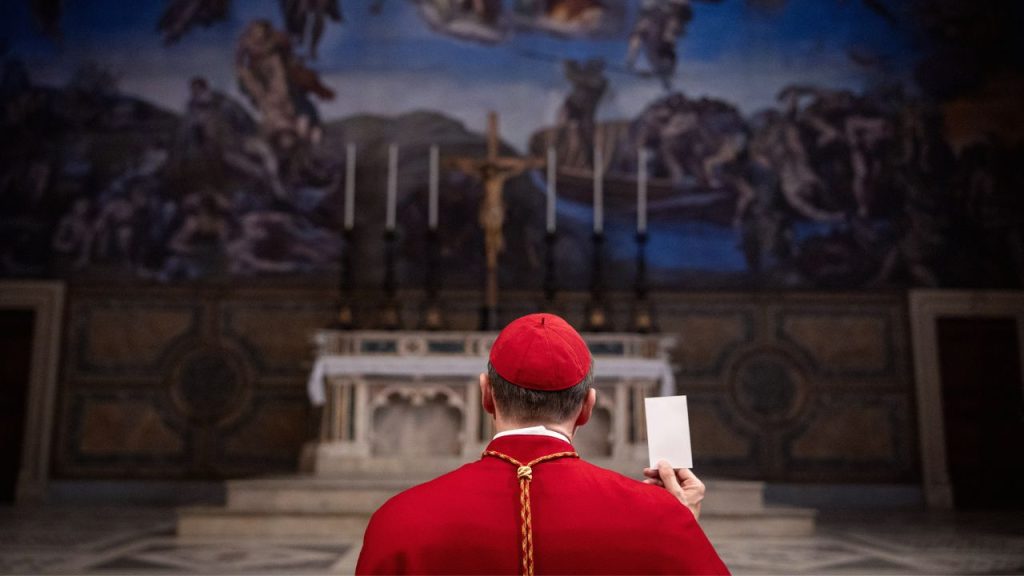Pope Francis, the Catholic Church’s first Jesuit pope, died on April 21 at age 88 after leading the church for over a decade. As Catholics around the world mourn his loss, all eyes are on the Vatican, where a select group of cardinals will convene to pay their respects and to choose a path forward.
As the 2024 film Conclave depicts, the death of a pope is a momentous event that triggers a series of carefully orchestrated rituals to ensure a smooth transition of papal authority. And according to Thomas Worcester, S.J., a papal expert and professor of history at Fordham who, like Pope Francis, is also a Jesuit priest, it’s anyone’s guess who will assume the papacy next.
Here’s a primer on what happens after a pope dies and how the next pope will be chosen.
(Editor’s note: This story was updated on April 24 to reflect events and announcements since the pope’s death.)
What happens when the pope dies?
First, the pope’s death is confirmed by the cardinal chamberlain, or camerlengo, in this case Cardinal Kevin Farrell, who becomes the acting administrator of the Vatican. Cardinal Farrell presided over the rite of the ascertainment of death and placement of Francis’ body in the coffin on Monday evening in the Chapel of the Vatican’s Casa Santa Marta, the Vatican said.
Pope Francis’ remains were brought to St. Peter’s Basilica in a simple wooden coffin on Wednesday morning; his body lies in state for public viewing. Cardinal Farrell will preside over the rite of the sealing of Pope Francis’ coffin on Friday night.
The Funeral Mass for Pope Francis will be held in St. Peter’s Square on Saturday, presided by Cardinal Giovanni Battista Re, dean of the College of Cardinals. After the Mass, the pope’s body will be taken into St. Peter’s Basilica and then to the Basilica of St. Mary Major, where he will be buried. The final resting place is a break with tradition; the basilica is a place where Pope Francis often went to pray in front of an icon of the Virgin Mary. It claims to have pieces of the crib where Jesus lay in Bethlehem. It’s also the place where St. Ignatius Loyola, the founder of the Jesuits, said his first Mass on Christmas morning.
When is the next pope chosen?
The church will observe nine days of mourning, with the first day being the day of the funeral Mass, the Vatican said. Typically within 15 to 20 days after a pope’s death, the dean of the College of Cardinals will summon the cardinals from around the world for the conclave to elect Francis’ successor.
According to Father Worcester, only cardinals under 80 are permitted to vote, a measure put in place by Pope Paul VI in 1970 to increase the odds of a more forward-looking candidate emerging.
Father Worcester said cardinals over 80 do take part in informal discussions in the lead-up to the conclave, however. During this time, they may discuss issues within the church, or simply get to know each other.
“There’s a kind of politicking that goes on. We like to think of it piously, as the Holy Spirit moving them, and I don’t deny that—but there’s also some politicking,” Father Worcester said.
Where is the papal conclave held?
The Church of Cardinals convenes in the Sistine Chapel, which hosted its first papal conclave in 1492. Sitting beneath Michelangelo’s The Last Judgment, the cardinals cast silent, secret ballots—up to four a day—until they reach a two-thirds majority.
How long does the conclave take?
The longest papal election took place in the 13th century and lasted nearly three years, but modern papal conclaves are much shorter than that. According to Father Worcester, a few days is more likely. “Anything over four days would really be a shocker because it would mean the cardinals cannot agree,” he said.
Who will be the next pope?
Several cardinals are being discussed as possible successors to Pope Francis. Father Worcester says that someone like Cardinal Pietro Parolin, the Vatican secretary of state who visited Fordham last year, may be a contender, given his high office and talent for diplomacy. But he also notes that the church has been moving away from Italian popes in recent decades.
Many media outlets have speculated about who the next pope will be. In this ABC News story, Cristina Traina, Ph.D., the Avery Cardinal Dulles, S.J. Chair of Catholic Theology at Fordham, discusses several front-runners.
One thing we’re unlikely to see in the near future, Father Worcester said, is another Jesuit in the role. He also does not expect the cardinal electors to choose a hard-line conservative, given that most of the cardinals appointed by Francis are progressives or moderates.
What does the smoke mean?
After each vote, the ballots are burned and a cloud of smoke rises from a chimney for the watchful eyes of the faithful gathered below. Black smoke signals that the cardinals have not reached a decision, while white smoke means the pope has been chosen.
When the white smoke emerges it sets in motion a rush of excitement, said Father Worcester, who was in St. Peter’s Square for John Paul I’s election in 1978.
“Over the next hour, the square filled completely with people. It was evening, the lights came up across the facade, the bells rang, and eventually [the pope]came out on the balcony,” he recalled. “It was an energizing moment.”

